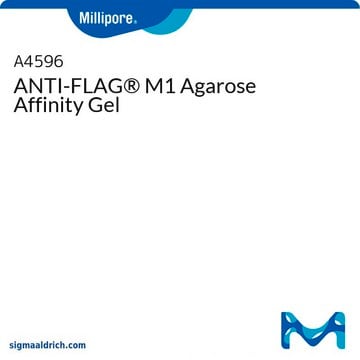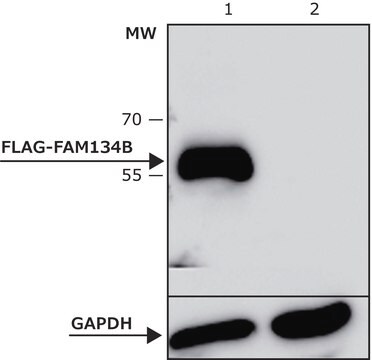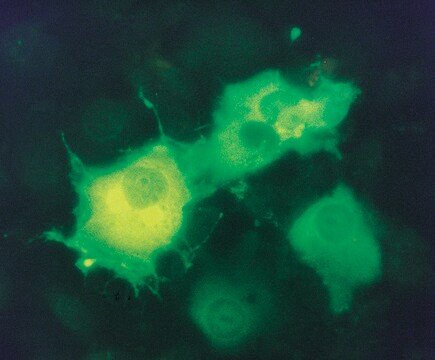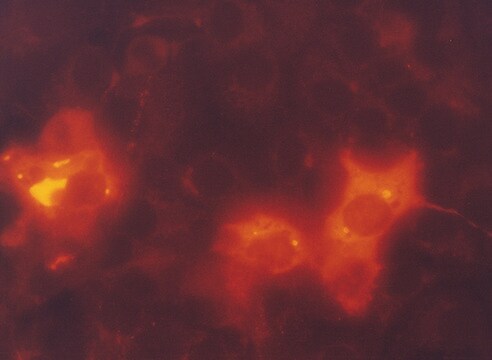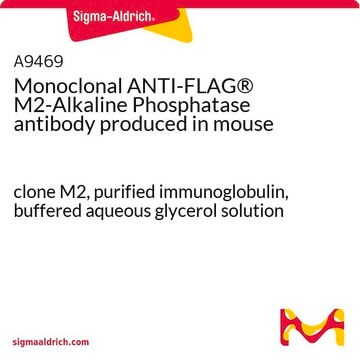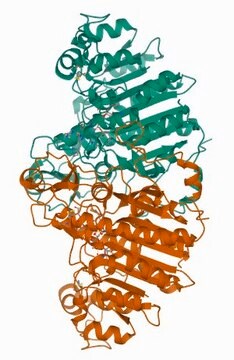F3040
Monoclonal ANTI-FLAG® M1 antibody
clone M1, purified immunoglobulin, buffered aqueous solution
Sinónimos:
Anti-ddddk, Anti-dykddddk
Iniciar sesiónpara Ver la Fijación de precios por contrato y de la organización
About This Item
Productos recomendados
origen biológico
(Bioreactor)
conjugado
unconjugated
forma del anticuerpo
purified immunoglobulin
tipo de anticuerpo
primary antibodies
clon
M1, monoclonal
Formulario
buffered aqueous solution
purificado por
using Protein A
reactividad de especies
all
concentración
2-5 mg/mL
técnicas
western blot: 10 μg/mL
secuencia del inmunógeno
DYKDDDDK
Condiciones de envío
dry ice
temp. de almacenamiento
−20°C
Descripción general
The ANTI-FLAG M1 IgG2b mooclonal antibody binds to proteins with a FLAG marker at the free N-terminus.
Method of purification - Protein A
Method of purification - Protein A
Inmunógeno
FLAG; peptide sequence DYKDDDDK
Aplicación
Monoclonal ANTI-FLAG® M1 antibody is suitable for immunoprecipitation, western blotting, or EIA in yeast, animal and E.coli cells.
Applications in which this antibody has been used successfully, and the associated peer-reviewed papers, are given below.
Chromatin immunoprecipitation (1 paper)
Immunofluorescence (1 paper)
Learn more product details in our FLAG® applications portal.
Applications in which this antibody has been used successfully, and the associated peer-reviewed papers, are given below.
Chromatin immunoprecipitation (1 paper)
Immunofluorescence (1 paper)
Learn more product details in our FLAG® applications portal.
Acciones bioquímicas o fisiológicas
Binds to the FLAG epitope when it is located at the free amino-terminus of a fusion protein. Does not bind to Met-FLAG fusion proteins, so will not recognize unprocessed, cytoplasmically expressed proteins. Binding is Ca2+-dependent; the complex dissociates in the absence of calcium ions.
Forma física
Solution in 10 mM sodium phosphate, 150 mM NaCl, pH 7.4, containing 0.02% sodium azide (w/v).
Nota de preparación
Dilute antibody to 10ug/mL in .05 M TBS, pH 7.4, containing 1 mM CaCl2.
Información legal
ANTI-FLAG is a registered trademark of Merck KGaA, Darmstadt, Germany
FLAG is a registered trademark of Merck KGaA, Darmstadt, Germany
¿No encuentra el producto adecuado?
Pruebe nuestro Herramienta de selección de productos.
Código de clase de almacenamiento
10 - Combustible liquids
Clase de riesgo para el agua (WGK)
WGK 1
Punto de inflamabilidad (°F)
Not applicable
Punto de inflamabilidad (°C)
Not applicable
Elija entre una de las versiones más recientes:
¿Ya tiene este producto?
Encuentre la documentación para los productos que ha comprado recientemente en la Biblioteca de documentos.
Los clientes también vieron
C Nie et al.
Cell death & disease, 5, e1495-e1495 (2014-10-31)
The protein kinase inhibitor 7-hydroxystaurosporine (UCN-01) is one of the most potent and frequently used proapoptotic stimuli. The BH3-only molecule of Bcl-2 family proteins has been reported to contribute to UCN-01-induced apoptosis. Here we have found that UCN-01 triggers Puma-induced
Andrew Best et al.
Nature communications, 5, 4760-4760 (2014-09-12)
Alternative splicing--the production of multiple messenger RNA isoforms from a single gene--is regulated in part by RNA binding proteins. While the RBPs transformer2 alpha (Tra2α) and Tra2β have both been implicated in the regulation of alternative splicing, their relative contributions
Eric J Gapud et al.
Journal of immunology (Baltimore, Md. : 1950), 187(4), 1826-1834 (2011-07-12)
Ataxia telangiectasia mutated (ATM) and DNA-dependent protein kinase catalytic subunits (DNA-PKcs) are members of the phosphatidylinositol 3-like family of serine/threonine kinases that phosphorylate serines or threonines when positioned adjacent to a glutamine residue (SQ/TQ). Both kinases are activated rapidly by
Reem Berro et al.
Journal of virology, 82(14), 7155-7166 (2008-05-16)
The human immunodeficiency virus type 1 (HIV-1) Tat is a 14-kDa viral protein that acts as a potent transactivator by binding to the transactivation-responsive region, a structured RNA element located at the 5' end of all HIV-1 transcripts. Tat transactivates
Mohammad Al Sorkhy et al.
BMC cancer, 12, 45-45 (2012-01-28)
Spy1 is a novel 'cyclin-like' activator of the G1/S transition capable of enhancing cell proliferation as well as inhibiting apoptosis. Spy1 protein levels are tightly regulated during normal mammary development and forced overexpression in mammary mouse models accelerates mammary tumorigenesis.
Nuestro equipo de científicos tiene experiencia en todas las áreas de investigación: Ciencias de la vida, Ciencia de los materiales, Síntesis química, Cromatografía, Analítica y muchas otras.
Póngase en contacto con el Servicio técnico


